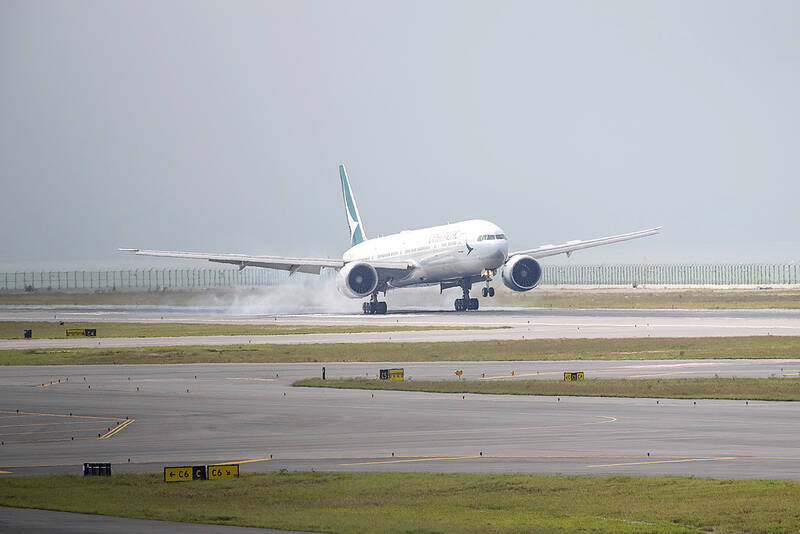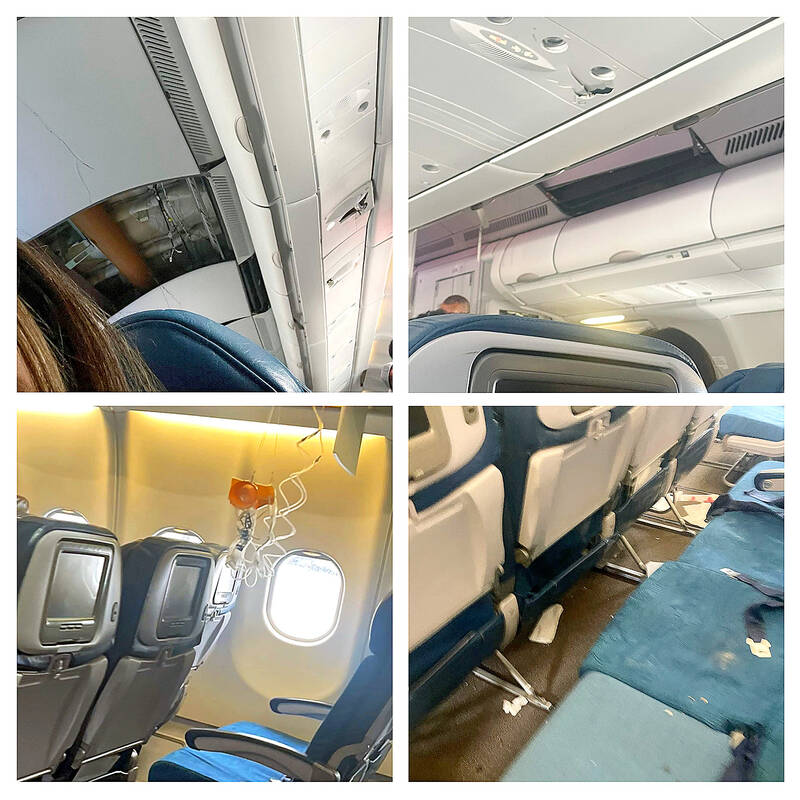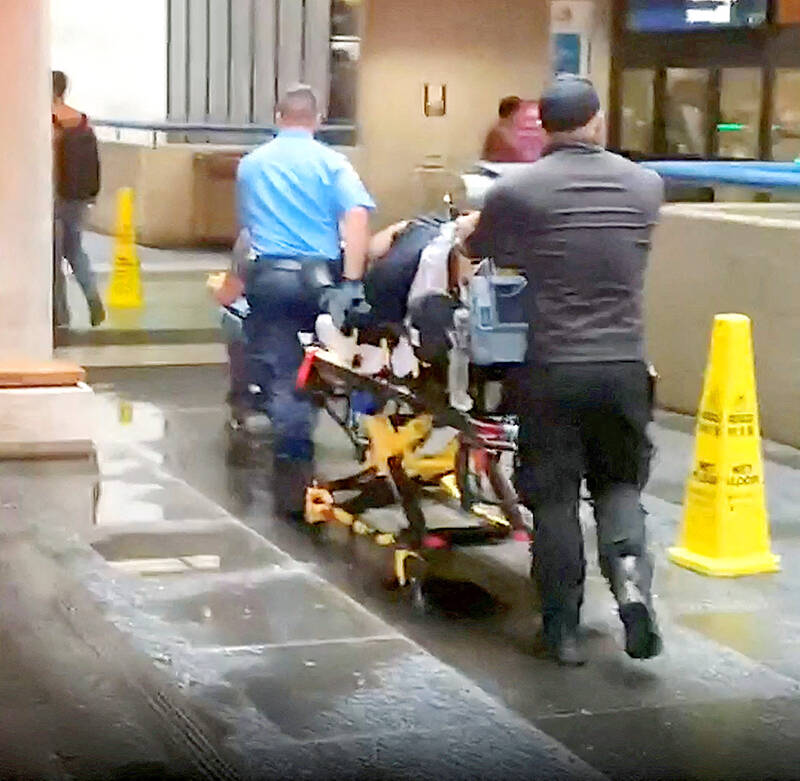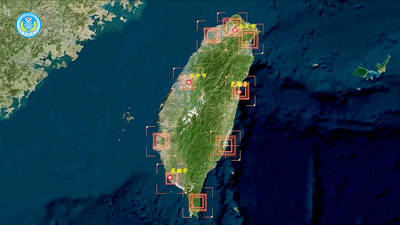The latest injuries from airplane turbulence were on flights to Honolulu and Houston, leading to a total of 41 people being hurt or receiving medical treatment in just two days — Sunday and Monday.
Back in July, severe turbulence led to at least eight minor injuries on a flight to Nashville, Tennessee, which had to be diverted to Alabama. Another three serious injuries to crew members were reported on three separate flights this year to Detroit, Miami and Columbus, Ohio, according to data from the National Transportation Safety Board.
US airlines have made steady improvements in their overall accident rate, but turbulence continues to be a major cause of accidents and injuries, according to a NTSB report last year. Turbulence accounted for 37.6 percent of all accidents on larger commercial airlines between 2009 and 2018.

Photo: AP
The Federal Aviation Administration also stated in a release Monday that there were 146 serious injuries from turbulence from 2009 to last year.
Climate change is expected to make turbulence worse in the coming decades, experts say. And while improvements in forecasting will help, not everyone expects the technology to ever be perfect.
In the meantime, the NSTB says that more can be done — both within the industry and among passengers. And everyone agrees that simply wearing a seatbelt during the entire flight will significantly reduce one’s risk of injury.

Photo: AP
WHAT IS TURBULENCE?
Turbulence is essentially unstable air that moves in a non-predictable fashion. Most people associate it with heavy storms. But the most dangerous type is clear-air turbulence, which can be hard to predict and often with no visible warning in the sky ahead.
Clear-air turbulence happens most often in or near the high-altitude rivers of air called jet streams. The culprit is wind shear, which is when two huge air masses close to each other move at different speeds. If the difference in speed is big enough, the atmosphere can’t handle the strain, and it breaks into turbulent patterns like eddies in water.

Photo: Reuters
“When those eddies are on the same scale as the aircraft, it causes one side of the aircraft to go up and one side to go down or causes the airplane to lose and gain altitude very quickly,” said Thomas Guinn, a meteorology professor at the Embry-Riddle Aeronautical University in Daytona Beach, Florida.
If pilots experience moderate turbulence, they can generally avoid it by flying to a higher altitude, Guinn said. But severe turbulence needs to be avoided all together.
“We can give kind of broad areas of where the turbulence is,” Guinn said. “If the indicators are for severe, then we generally expect pilots to to avoid those regions.”
WHAT ROLE DOES CLIMATE CHANGE PLAY?
Paul Williams, a professor of atmospheric science at the University of Reading in England, says global warming is changing temperature patterns in the upper atmosphere. And that is causing more instability in the jet streams.
“More specifically, at flight-cruising altitudes, the tropics are warming more rapidly than the poles ... leading to stronger north-south temperature differences across the jet stream, and it is those temperature differences that drive the wind shear,” Williams wrote in an e-mail.
But the implications for air travelers are still not fully known, he cautioned.
“One could argue that pilots should be getting better at avoiding turbulence over time, because the specialized forecasts that are used to seek out smooth routes are gradually improving,” Williams wrote. “So more turbulence in the atmosphere will not necessarily translate into more injuries.”
HOW COMMON ARE TURBULENCE-RELATED INJURIES?
The NTSB’s report last year showed that there were 111 turbulence-related accidents between 2009 and 2018 that resulted in at least one serious injury. That figure applies to commercial carrier planes with more than nine passenger seats.
“Most passengers seriously injured ... are either out of their seats or seated with their seat belts unfastened,” the report said.
Flight attendants — who are often up and moving — were most commonly hurt, accounting for 78.9 percent of those seriously injured.
Numbers released Monday by the FAA showed a similar breakdown between 2009 and last year: 116 of the 146 serious turbulence injuries — or 79 percent — were among crew.
Accident reports filed with the NTSB provide examples. For instance, turbulence on a flight from Dallas-Fort Worth to Miami in July last year resulted in a flight attendant “striking the floor hard” in the aft galley and being diagnosed with “a fractured compressed vertebra.”
On another flight from San Antonio to Chicago in August of last year, a flight attendant “had fallen to her knees because of the turbulence” and “was diagnosed with a fractured kneecap.” And on a flight from Baltimore to Atlanta in October last year, a flight attendant fell and broke her ankle during drink service when the plane “unexpectedly entered a cloud and experienced moderate to borderline severe turbulence.”
“When turbulence occurs, it can be severe and lead to significant, very serious injuries: everything from broken bones to spinal issues to neck issues,” NTSB Chair Jennifer Homendy said in an interview.
WHAT CAN BE DONE?
The NTSB’s report last year offered a long list of recommendations. They included more information-sharing among pilots, carriers and air traffic controllers regarding the weather and turbulence incidents.
“We want to make sure that the best suite of technologies is used ... to provide the best information to pilots and flight attendants and passengers,” Homendy said.
The agency also urged revisions to safety recommendations regarding when flight attendants should be secured in their seats, including portions of descent, which would “reduce the rate of flight attendant injuries.”
The report also cited parents who have been unable to hold infants securely on their laps during turbulence. The NTSB stated that it’s safest for children under the age of two to be in their own seat and using an appropriate child restraint system.
Michael Canders, director of the Aviation Center at Farmingdale State College in New York, said many in the industry are already sharing information with each other regarding turbulence, while forecasting has improved over the years.
But he’s unconvinced that it will ever be perfect.
“There’s this argument or debate about, ‘Will technology save us or do we need to back off and take better care of the earth?’ ” said Canders, who is also an associate professor of aviation. “I think we have to do both.”
Canders added that preventing injuries from turbulence is “best addressed by sitting in your seat and seat-belting in.”

A vaccine to fight dementia? It turns out there may already be one — shots that prevent painful shingles also appear to protect aging brains. A new study found shingles vaccination cut older adults’ risk of developing dementia over the next seven years by 20 percent. The research, published Wednesday in the journal Nature, is part of growing understanding about how many factors influence brain health as we age — and what we can do about it. “It’s a very robust finding,” said lead researcher Pascal Geldsetzer of Stanford University. And “women seem to benefit more,” important as they’re at higher risk of

Eric Finkelstein is a world record junkie. The American’s Guinness World Records include the largest flag mosaic made from table tennis balls, the longest table tennis serve and eating at the most Michelin-starred restaurants in 24 hours in New York. Many would probably share the opinion of Finkelstein’s sister when talking about his records: “You’re a lunatic.” But that’s not stopping him from his next big feat, and this time he is teaming up with his wife, Taiwanese native Jackie Cheng (鄭佳祺): visit and purchase a

April 7 to April 13 After spending over two years with the Republic of China (ROC) Army, A-Mei (阿美) boarded a ship in April 1947 bound for Taiwan. But instead of walking on board with his comrades, his roughly 5-tonne body was lifted using a cargo net. He wasn’t the only elephant; A-Lan (阿蘭) and A-Pei (阿沛) were also on board. The trio had been through hell since they’d been captured by the Japanese Army in Myanmar to transport supplies during World War II. The pachyderms were seized by the ROC New 1st Army’s 30th Division in January 1945, serving

The People’s Republic of China (PRC) last week offered us a glimpse of the violence it plans against Taiwan, with two days of blockade drills conducted around the nation and live-fire exercises not far away in the East China Sea. The PRC said it had practiced hitting “simulated targets of key ports and energy facilities.” Taiwan confirmed on Thursday that PRC Coast Guard ships were directed by the its Eastern Theater Command, meaning that they are assumed to be military assets in a confrontation. Because of this, the number of assets available to the PRC navy is far, far bigger